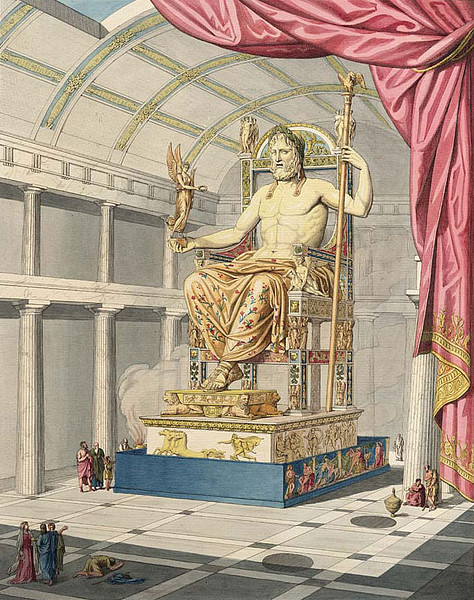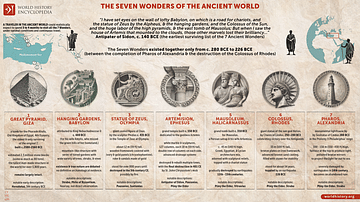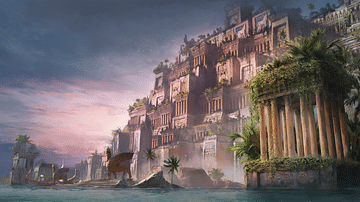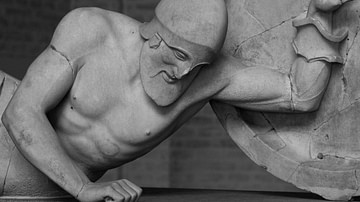
The monumental statue of Zeus at Olympia in Greece was one of the Seven Wonders of the Ancient World. Created in the 430s BCE under the supervision of the master Greek sculptor Phidias, the huge ivory and gold statue was bigger even than that of Athena in the Parthenon. Worshipped by pilgrims from across the Mediterranean, the statue inspired countless imitations and defined the standard representation of Zeus in Greek and Roman art in sculpture, on coins, pottery, and gemstones. Lost in later Roman times following its removal to Constantinople, Phidias' masterpiece captivated the ancient world for 1,000 years and was the must-see sight for anyone who attended the ancient Olympic Games.
Phidias, Master sculptor
The master sculptor and architect Phidias (also spelt Pheidias, active c. 465-425 BCE), who had already supervised construction of the Parthenon (447-432 BCE) in Athens and its giant statue of the city's patron goddess Athena, was called on again to produce a similarly monumental sculpture of Zeus. The location was to be Olympia in the western Peloponnese of Greece where a huge brand new temple awaited. It was there that, every four years, the Pan-Hellenic Olympic Games (776 BCE - 393 CE) were dedicated. Olympia was then controlled by the polis (city-state) of Elis and the sacred site attracted thousands of travellers, pilgrims, and sports fans from across the Mediterranean. The new cult statue and temple to house it would be fine additions, adding prestige to Olympia at a time when there were still rival games held at other sites such as Delphi, Nemea, and Isthmia near Corinth. In addition, a magnificent dedication to Zeus, father of the Olympian gods and supreme deity of the ancient Greek religion, could only be a positive for the Eleans' and indeed all of ancient Greece's spiritual and material well-being.
Phidias was the perfect choice for what would be a challenging project requiring hundreds of craftsmen and several years of work. The master sculptor moved to Olympia, and excavations in the 20th century CE revealed his workshop, which contained a simple red-figure Attic cup or wine jug (oinochoe) inscribed in Greek Pheidio eimi, “I belong to Phidias”. The workshop also contained ivory tools, a small hammer for working gold, and moulds for pieces of a large female statue.
The Temple
In the 5th century BCE, the sanctuary of Olympia reached its peak of prosperity and a massive Doric 6 x 13 column temple was begun c. 460 BCE. Completed c. 457 BCE, it was designed by Libon of Elis and it was the biggest in Greece at that time, measuring over 20 metres (65.5 ft) in height, 64.12 x 27.68 m (210 x 91 ft) along its sides with columns 10.53 m (34.5 ft) in height and 2.25 metres (7 ft) in diameter at their base. The pediments of the temple displayed magnificent sculpture: on the east side the mythical chariot race between Pelops and Oinomaos, and on the western pediment a battle scene with centaurs (Centauromachy) with the majestic central figure of Apollo. Metopes from the temple represented the labours of Hercules. Many of these decorative figures sculptures survive today and can be seen at the museum at the archaeological site of Olympia.

The Statue
In the religion of ancient Greece, a temple was considered the dwelling place of a god, as its name naos ('dwelling') suggests. Thus, the statue of the deity inside was far more important than the temple itself. The figure was typically placed in the centre of the building so that when its doors were opened it could look out upon the sacrifices and ceremonies being performed just outside in that god's honour. Whether the worshippers actually believed that the god somehow inhabited the statue is a moot point, but certainly prayers and ritual gestures were directly addressed to it. It is also interesting to note that one of the common names for a statue in Greek was zōon or “living thing”, such was the endeavour of the sculptor to capture living matter in unfeeling bronze or marble. Certainly, Phidias' vision was of a statue so large and gleaming in gold that it would be nothing short of an awe-inspiring epiphany to the onlooker, it would provide as close a link as possible between humanity and the divine.
The statue of mighty Zeus was over 12 m (40 ft) high and represented the god seated on a throne. It was bigger even than Phidias' Athena Parthenos in Athens. The Zeus statue, like Athena, was chryselephantine, that is a combination of gold and ivory over a wooden core, with the god's skin (face, torso, arms and legs) being in ivory and his beard, robes, and staff rendered in brilliant gold, applied in hammered sheets. Fine details were picked out using a wide variety of materials: silver, copper, glass (for the decorative lilies of the god's robes), ebony, enamel, paint, and jewels. The clay moulds discovered in Phidias' workshop for a similar statue suggest that it was first erected there in pieces - the size of the workshop is exactly the same dimensions as the inner cella of the temple - and then reassembled at its final destination. The wooden core could not have been fully sculpted or the moulds would have been unnecessary to shape the outer gold pieces.
The most complete description of the sculpture from ancient sources is to be found in the Description of Greece by the 2nd-century CE Greek geographer and traveller Pausanias:
The god sits on a throne, and he is made of gold and ivory. On his head lies a garland which is a copy of olive shoots. In his right hand he carries a Victory [Nike], which, like the statue, is of ivory and gold; she wears a ribbon and—on her head—a garland. In the left hand of the god is a sceptre, ornamented with every kind of metal, and the bird sitting on the sceptre is the eagle. The sandals also of the god are of gold, as is likewise his robe. On the robe are embroidered figures of animals and the flowers of the lily. The throne is adorned with gold and with jewels, to say nothing of ebony and ivory. Upon it are painted figures and wrought images. (Book 5, Ch. 11)
Zeus' throne - made using ivory, ebony, and gold, and encrusted with glass and gems - was embellished with relief sculpture depicting a wide range of figures from Greek mythology, many of which were considered the offspring of Zeus. There are the Graces (Charites), the Seasons (Horae), various Nikes, sphinxes, Amazons, and the children of Niobe. The screens between the legs of the throne were painted by Phidias' brother Panaenus (Panainos) and depicted the Labours of Hercules, Achilles with Penthesilea, Hippodamia with Sterope, Salamis, and scenes of Greece. The god rested his feet upon a footstool which was decorated with a battle scene involving Theseus fighting Amazons (Amazonomachy).
The figure of Zeus, throne, and stool, were all placed on a base of black Eleusinian marble which measured 9.93 x 6.25 metres (32.5 x 20.5 ft) along its sides. The base was decorated with scenes of the Birth of Aphrodite. Finally, the base was signed by Phidias with the words “Phidias, son of Charmides, an Athenian, made me”.

The statue stood in front of a shallow pool of diluted or pure olive oil (as opposed to water in the case of the Athena Parthenos) which helped keep a moist atmosphere and impede any cracking of the ivory pieces. The reflection of the statue in the pool was a bonus side-effect to add to its aura of other-worldliness. The finished statue was dedicated c. 430 BCE.
The Seven Wonders
Some of the monuments of the ancient world so impressed visitors from far and wide with their beauty, artistic and architectural ambition, and sheer scale that their reputation grew as must-see (themata) sights for the ancient traveller and pilgrim. Seven such monuments became the original 'bucket list' when ancient writers such as Herodotus, Callimachus of Cyrene, Antipater of Sidon, and Philo of Byzantium compiled shortlists of the most wonderful sights of the ancient world. The great statue of Zeus made it onto the established list of Seven Wonders from the 2nd century BCE, but it was by then already widely known, imitated in sculpture and represented in vase paintings, carved gemstones, and on coinage from the 4th century BCE, notably on the reverse side of the silver tetradrachms of Alexander the Great (336-323 BCE) and the coins of Elis. Roman emperor Hadrian (r. 117-138 CE) was still using the same image on his coins in the 2nd century CE. Besides these surviving representations, there are marble copies of the children of Niobe from the throne of the statue.
The Zeus statue, then, attracted people from across the known world. Individuals and city-states brought offerings to Zeus, which included money, fine statues (including the magnificent Nike of Paionios, c. 424 BCE, and the Hermes of Praxiteles, late 4th century BCE), bronze tripods, shields, helmets, and weapons resulting in Olympia becoming a living museum of Greek art and culture. Many cities also built treasuries - small but impressive buildings to house their offerings and raise the prestige of their city.
It was Roman Emperor Theodosius I (r. 379-395 CE) who, favouring Christianity, decreed that all cult practices, including the Olympic Games, be stopped, and the final Olympics was held in 393 CE after a run of 293 games over more than a millennium. After that time the site and temple fell into disrepair until it was desecrated c. 426 CE following a decree against pagan temples by Theodosius II (r. 402-450 CE) and then completely destroyed by earthquakes in 522 and 551 CE. The ruins were eventually covered in silt brought by the River Alpheus as it slowly changed its course over time.
The statue would not suffer the same fate as the temple, though, as the two were destined to be separated and never reunited. The statue was renovated several times, cracks in the ivory were repaired, and even perhaps supporting columns added under the throne. Roman emperor Caligula (r. 37-41 CE) had audaciously tried to remove the statue and have it brought to Rome, but according to the Roman writer Suetonius (c. 69 - c. 140 CE), the project was abandoned after the giant Zeus mysteriously emitted a roar of laughter and the scaffolding of the workers collapsed. The next indignity was having its gold parts spirited away by Roman Emperor Constantine I (r. 306-337 CE). Finally, the statue of Zeus was removed to Constantinople in 395 CE, then the capital of the Eastern Roman Empire, where it and the temple or palace it stood in were destroyed during an earthquake or tsunami in the 5th, or more likely, 6th century CE. An alternative theory, as recorded in the works of the historians Zonaras and Kedron, is that the statue was destroyed by a fire in 475 CE. Whatever the exact causes of its final loss, the surviving descriptions by ancient writers and the tantalising images in other ancient artworks and on coins are all that survive of one of the wonders of the ancient world, the only one that was ever genuinely revered.









